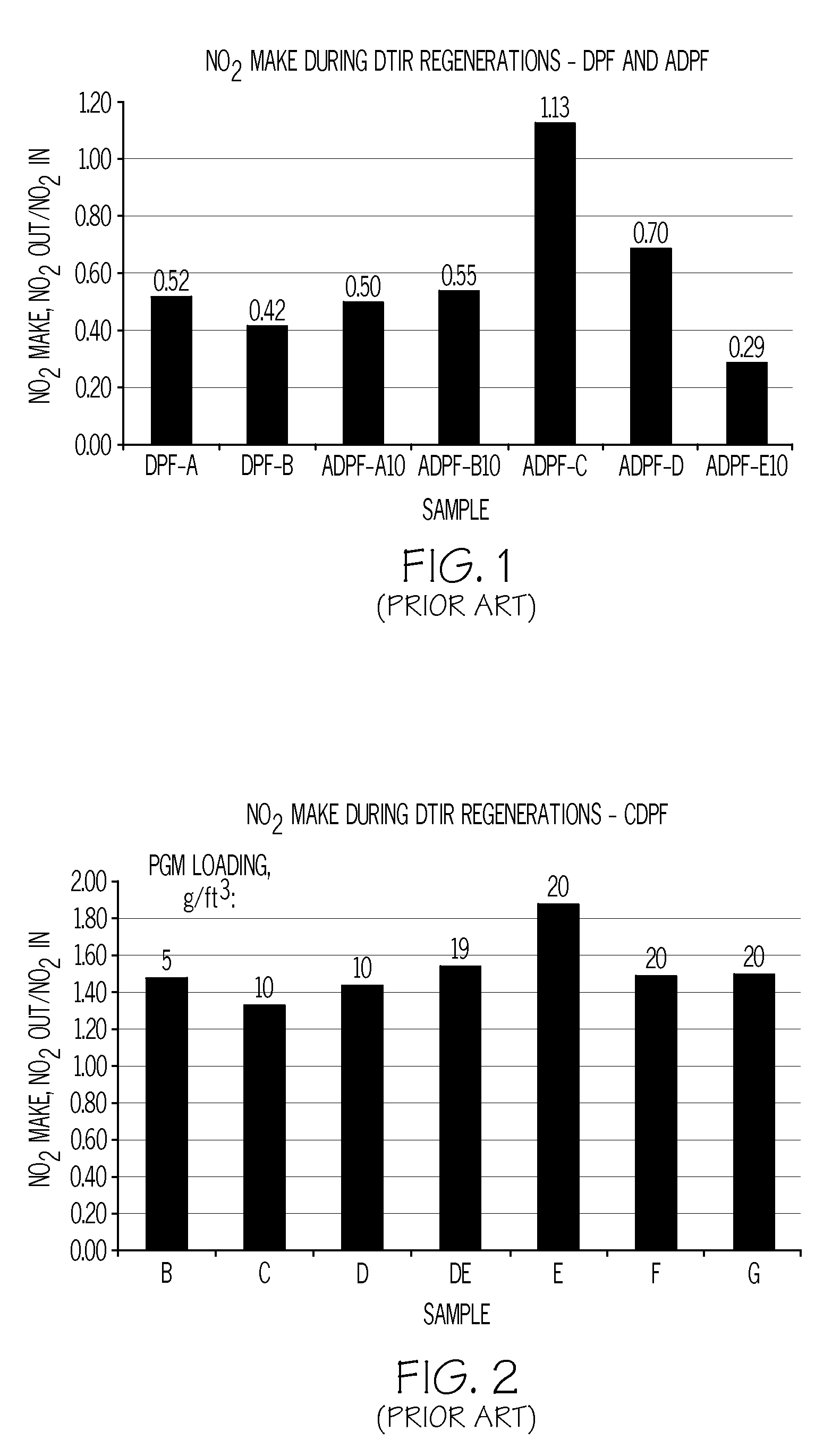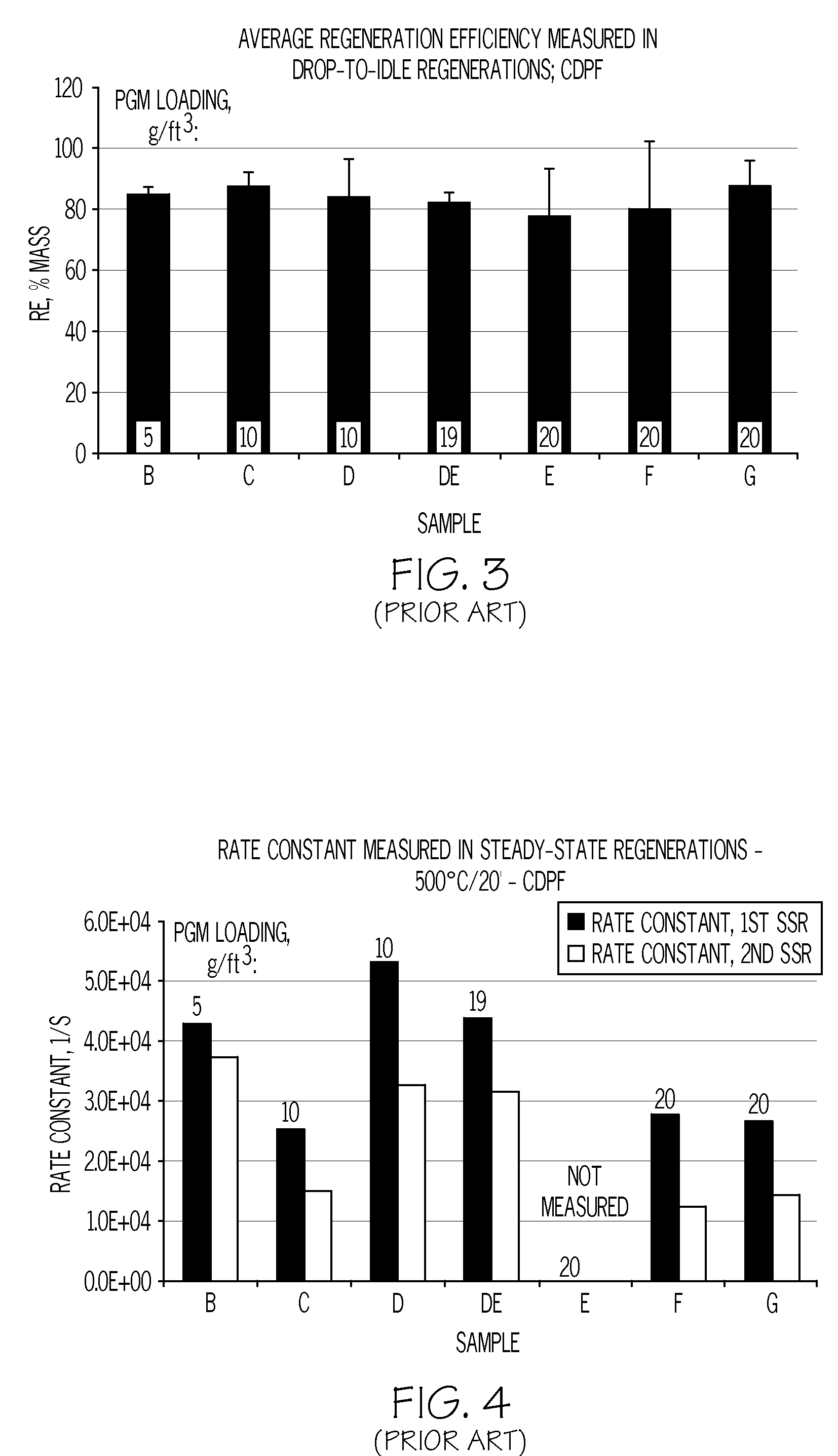Catalyst composition for diesel particulate filter
a technology of catalyst composition and diesel particulate filter, which is applied in the direction of physical/chemical process catalyst, arsenic compound, separation process, etc., can solve the problems of increasing the amount of nitrogen dioxide (nosub>2/sub>) emissions, affecting the lungs, and affecting the oxidation effect of soo
- Summary
- Abstract
- Description
- Claims
- Application Information
AI Technical Summary
Benefits of technology
Problems solved by technology
Method used
Image
Examples
example 1
Preparation of Catalyzed Diesel Particulate Filters
[0053]A number of diesel particulate filters were prepared using the catalyst composition in accordance with the present invention. Sample #55 is a comparative sample which was prepared without the use of Co and / or Fe oxides.
Sample Filter #32
[0054]A cordierite filter (mass m=1048 g) was impregnated with a solution containing 250 m of zirconyl acetate; 30 ml glycerol, 17 g saccharose, 5 g lanthanum acetate, and distilled water to a total volume of 550 ml to form a La-stabilized zirconia washcoat. The sample was dried at 117° C. and calcined at 750° C. for 3 hours. The diesel particulate filter was then impregnated with a solution containing dihydrogen hexachloroplatinate, copper nitrate, lanthanum nitrate, iron (III) nitrate, cobalt nitrate and cerium (III) nitrate. The Pt loading was 1.76 g (corresponding to a concentration of 20 g / ft3), CuO loading was 17.5 g; La2O3 loading was 34.9 g, Fe2O3 loading was 22.0 g, Co3O4 loading was 12...
example 2
[0060]The sample filters produced in accordance with Example 1 were tested in comparison with reference (commercial) samples containing higher Pt loadings, non-catalyzed (uncoated) DPF samples, and fuel-assisted DPFs (ADPFs) on an engine dynamometer with 2.0 L common rail (CR) diesel engine equipped with a commercial diesel oxidation catalyst (DOC) in a close-coupled position to determine the amount of NO2 produced during filter regeneration.
[0061]Two different types of regeneration methods were used: drop-to-idle regeneration (DTIR) and steady-state regeneration (SSR). By DTIR, it is meant that after initiation of regeneration determined by decrease of backpressure, the engine was switched to idling conditions, providing low flow through the filter and high oxygen concentration (causing the highest peak temperature during regeneration) to evaluate filter regeneration under severe conditions, i.e., conditions favorable for development of high peak temperatures inside DPF).
[0062]By S...
PUM
| Property | Measurement | Unit |
|---|---|---|
| temperature | aaaaa | aaaaa |
| temperature | aaaaa | aaaaa |
| temperatures | aaaaa | aaaaa |
Abstract
Description
Claims
Application Information
 Login to View More
Login to View More - R&D
- Intellectual Property
- Life Sciences
- Materials
- Tech Scout
- Unparalleled Data Quality
- Higher Quality Content
- 60% Fewer Hallucinations
Browse by: Latest US Patents, China's latest patents, Technical Efficacy Thesaurus, Application Domain, Technology Topic, Popular Technical Reports.
© 2025 PatSnap. All rights reserved.Legal|Privacy policy|Modern Slavery Act Transparency Statement|Sitemap|About US| Contact US: help@patsnap.com



